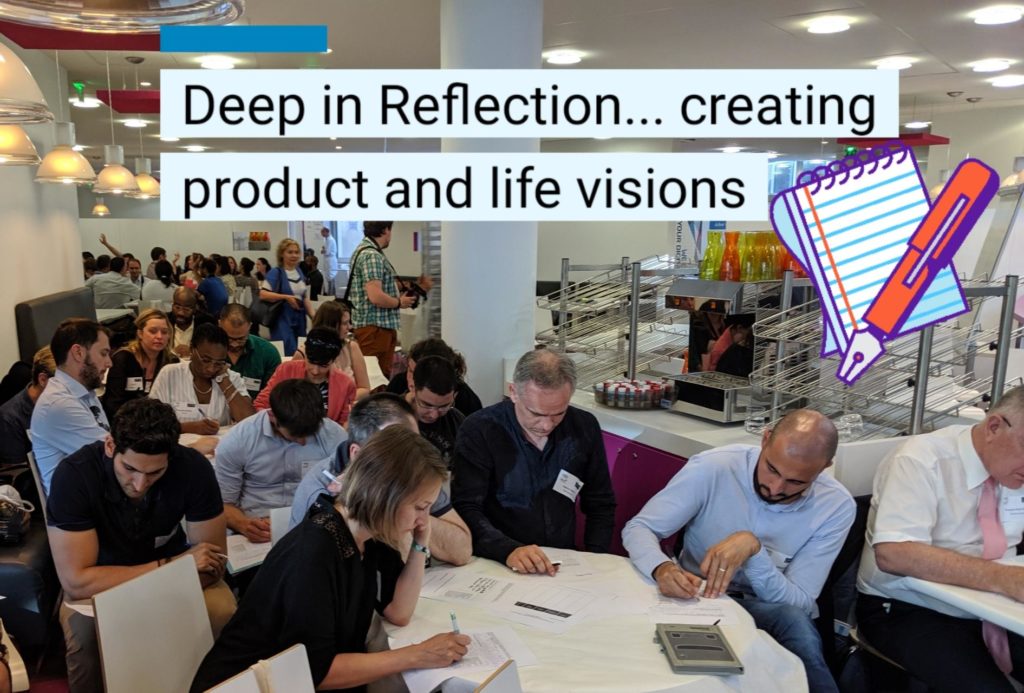The question I have been delving into lately:
And what if I use my professional skills for social/environmental good?
Are these two worlds so mutually exclusive?

I am just at the start of my journey but so far from my ‘market’ and in person research (lol Product Owner habits die hard)… The answer is:
Yes, it is possible.
Not only is it possible, more than ever, but there are many people out there like me who want to do the same. In addition, companies are awakening to their societal and environmental responsibilities, if only for the reason that their clients desire it and it will increase their employer desirability.
I am increasingly convinced that the economy of tomorrow is one that is socially/environmentally (social good) conscious. It will not be a question but a fact for companies, that they must integrate social good into their DNA to survive. If we look purely at money, the market will demand this even though the environmental doomsday we are heading towards should be motivation enough. But, hey money talks.
So you desire to use your skills to have an impact? In this article I will give you one idea and some inspiration, but to see the full buffet at your disposition that is a post for another day. Though, if you speak french, here are some notes and ideas from a meetup I helped organize on the subject with some like-minded coaches, Nathaniel and Julien. Meanwhile, please reach out to me as I want to meet more professionals on this adventure.
Quick background: How to have an impact without switching jobs? And what is Pro Bono Day?
So in exploring all my options, one option came up called: Pro Bono or donating skills (without switching jobs) to causes that could not normally pay for them. Or for company owners, allowing and facilitating their employees to do this on company time and dime.
Some options for this (some France only):
- https://globalprobono.org/ – network to find your local provider
- https://probonolab.org/
- https://vendredi.cc/
- https://www.passerellesetcompetences.org/
This is a great opportunity as not only is it an opportunity to share what we love to do at work but we can develop our skills further by using them in new domains. Also, often it is a write-off for companies providing it on their time, win-win.
Pro Bono Lab organized a day long conference on this subject called
Pro Bono Day with voices from a diverse set of actors and below are some of my learnings and reactions. My notes are not as complete as I would like, so apologies in advance if I do not give credit due. Please email me any corrections, for those who were there. Here is a the full program with all the names of some inspiring organisations and people. Shout out to my fellow coach friend Nathaniel Richand of Permagile who experienced it alongside me.

One of the many roundtables: Flavie Deprez (Carenews) , Anita Kirpalani (Epic Foundation), Adélaïde de Tourtier (PWC) et Emery Jacquillat (La Camif).
Some Big Ideas
On a personal level…
- All skills can be used for the betterment of society. We need all our minds on the issues at hand and not just our “best” minds. You may think your skills are unique to your job but often if you break them down into general know-how areas they are easily applicable elsewhere. Example: A project manager who manages CRM software system deployments knows: logistics, time management, detail orientation, systems thinking, interpersonal skills etc. So despite being quite specialized in their daily work, this person could share their knowledge with a charity that needs help structuring their supply chain or deploying an intranet. Do not forget, this arsenal of skills includes those acquired in your personal life. This same project manager organizes family meals for 15 people every Sunday? Logistics and people wrangling again! This time for nonprofit…
- You are your greatest masterpiece, with no completion date. There is no expiration or prematurity of your skills. We tell the young they are not experienced enough to share their skills to help others… The old, too much experience or not relevant. The middle-aged too irresponsible… Must earn money, no? Enough, we all have something to share and gain. Often just a different perspective alone is an asset. Resource: Mélissa Petit of https://www.mixinggenerations.com/ is doing a lot of work to help us understand the unexploited power of our elder generations (a.k.a. us one day!).
- The best way to learn is to do and create, working on the causes that you relate to. Programs such as Toukouleur and Enactus believe in this power of learning and gaining confidence via launching projects from A-Z, especially for adolescents. So why not create your own local project or Pro Bono help someone with theirs? In addition, it is recommended to focus on the causes that motivate you most personally as they will keep you driven. There is enough diverse interests out there to cover our most pressing issues.
- The best way to gain understanding of others is to do alongside them. To do Pro Bono is to not subjugate your help on others but to come to the table to see how you can collaborate and elevate each other’s efforts. Those we are “helping” have key essential knowledge that must be taken into full account.
- There is no “too little” and each cause their merit. Any drop of help is not too little nor should be shamed. Some can give an hour a year, some dedicate a whole sabbatical to helping, and that is fine. We are also not all motivated by the same causes and all enter this journey at a different time and from different places. What counts is we take a step and open up to and grow our spirits thanks to social good.
On a company level…
- Pro Bono or social good programs should never be used as a band-aid for bad HR and unethical practices or to sway public opinion. (Anita Kirpalani – Epic Foundation) They should be done with the pure intention to inspire our employees and enrich their lives and skills. You may try to fake it but this is a type of “greenwashing,” where the intention is only to hide faults, will easily be recognized as false from within and around.
- True intention? With time people will tell. There is a lot of public apprehension when money enters the social good sphere, but be consistent in all actions and persistent and with time your intention will be clear. Even if you have to take breaks at points to rethink your approach, that is more than fine, it does not mean people will not understand in the long run your intent.
- One way to embody this intention is for the direction or company leaders to go out and move forward their social-good goals. This could be as simple as the leaders taking part of a Pro Bono or nonprofit initiative themselves. Lots of social good organisations or nonprofits may need your experience! As mentioned above on the personal level, this is an opportunity not only to share knowledge but grow and better inform the leadership of the company. It is valuable time spent.
- Set your intention… have a mission statement that is clear and guides all actions and products on all levels. This mission must be co-created, owned and referred to constantly by everyone involved and surrounding you. Perhaps this means reconnecting with an old mission statement or emerging a new one. This mission statement can be the driving force to go from ‘doing’ to ‘being’. Find or refind your mission’s pulse regularly by seeking the opinions of your employees, clients and society at large. They are the true meter and not your own opinions. Do not just stop at your clients but take in consideration the opinion of those in the locations where you produce and the localsphere of your clients.
- As often… When we build a product we think: will it work and can we scale? But we are missing an essential 3rd question: and how does it effect our society? There is no private-only sphere of influence… Everything has a societal effect. – Charlest Benoît Heidsieck of Le Rameau
- Forget the “perfect” model, we must all find our own “pertinent” model. Our strength is in our diversity. – Charlest Benoît Heidsieck of Le Rameau on finding the perfect social-good model. This principle can be applied to so many other situations! Best is to be inspired by others but in the end build a model to fit our, our clients’ and our localsphere’s needs and unique motivations.
- So that means… As organisations we must break down silos between government, public and charitable organisations. What was once a small microsystem is rapidly expanding and now an ecosystem. We can harness this power by collaborating and doing business between all types of social good organisms. Also, as consumers we must vote with our money.
- It bears repeating: Companies must engage or die. Impact + profit, not just profit. Consumers want sincerity and social awareness. And our children will (and already do) want even more.

One last big question…
- “No, the question is not how can tech save us… But how can the Probono and sharing our skills for a societal impact save tech?” – Charlie Tronche of HelloAsso
Pandora’s Box
In the end the gift I got out of this conference and my recent adventures into this new world, is hope. Easy to be fatalist until you go out and see the doers. And we are amassing an army.
So go out there and do. And don’t hesitate to contact me to discuss in the meanwhile. If you live in Paris, our next meetup for social good curious and doers is November 20th. Join us! Allez-y!





